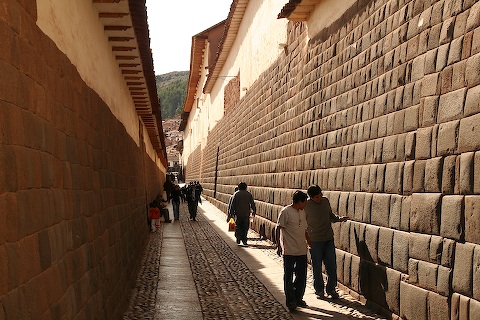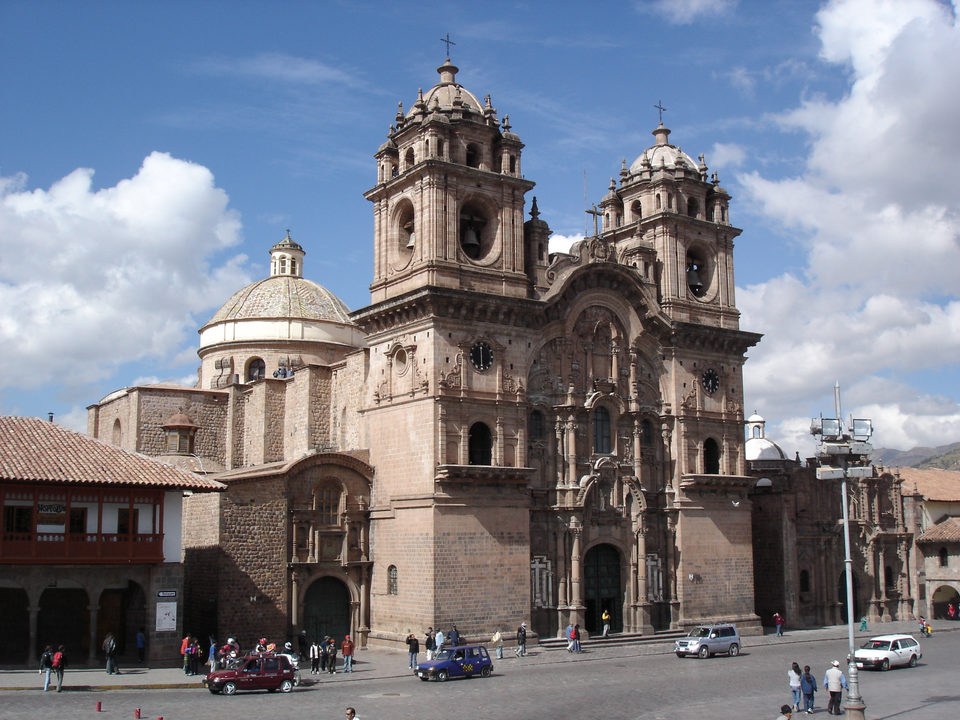The Last Days of the Incas’ Peru Tour #7 (Cusco)
posted on May 28th, 2008 in Cuzco: Information about the former Inca capital, Incas, Peru, The Last Days of the Incas' Peru Tour
Cusco (3-4 Days)
Visiting the Location where Diego de Almagro Captured Hernando and Gonazalo Pizarro During Almagro’s Seizure of Cusco in 1537
(Above: Loreto Street in Cusco; on the left is the wall of the Inca palace known as the Amaru Cancha.On the right is the outside wall of the Acclawasi, or the temple of the “Chosen Women”).
It was in 1537, shortly after Manco Inca lifted his siege of Cusco, on the southeastern portion of Cusco’s Plaza de Armas, where Hernando Pizarro, his brother Gonzalo, and about twenty followers were seized by Diego de Almagro—the first in a chain of incidents that would lead to a deadly civil war. The Pizarros had holed up in Huayna Capac’s former palace of Amaru Cancha in 1537, just as Diego de Almagro, Pizarro’s former partner, had returned from Chile. Much of the site is now occupied by the Jesuit church, La Compañía; however, some of the wall of the Amaru Cancha can still be seen on the eastern side of Loreto Street, that runs from the southeastern part of the square (Amaru Cancha, in the Incas’ language, Quechua, means “Snake House” or “House of the Serpents”; the snake among the Incas was a symbol of knowledge and learning, a stone with a carved snake can still be seen along Calle Loreto, on one of the Amaru Cancha’s walls)…
Quoting from Chapter 11 of The Last Days of the Incas:
“Since the recent lifting of Manco’s siege, the Spaniards in Cuzco were now no longer holed up in the two buildings on the main square. Many had returned to their original homes in the city, at least those homes that had not been consumed in the great fire. Hernando had already re-established himself in Huayna Capac’s former palace on the eastern side of the main square, known as the Amaru Cancha; somehow, the palace had miraculously escaped being burned.
Hernando, Gonzalo, and about twenty Spaniards loyal to the Pizarro’s now set up artillery in the doors of the palace and used it as a redoubt, determined to resist if Almagro did indeed try and seize Cuzco. Although some thought that Hernando’s distrust of Almagro was over exaggerated, in this case at least, those suspicions turned out to be more than justified.
On the night of April 18, 1537, at about two A.M. in the morning, a heavy cold rain beat down upon the slumbering city. Diego de Almagro, seasoned commander that he was, had chosen this precise moment–when his forces would be least expected–to attack. With cracks of lightening periodically illuminating the night, Almagro and his men entered the city and quickly captured the church of Hatun Cancha on the main square, one of the two buildings Hernando’s men had taken refuge in during the siege. Other captains now seized the principal streets of the city, deploying more than two-hundred-and-eighty cavalrymen in the process. Almagro’s second-in-command, Rodrigo Orgóñez, meanwhile—the same man who had beaten out Hernando de Soto for that position—led a detachment that quickly surrounded the Amaru Cancha palace, where Hernando and Gonzalo Pizarro and about twenty men were still sleeping, unaware that a political coup was unfolding just beyond their doors.
It wasn’t until the Inca capital was already firmly in Almagro’s control that Hernando and his men first realized that something was amiss. Leaping up, Hernando, Gonzalo and the rest of the Spaniards grabbed their weapons and quickly began fighting a fierce battle against their attackers, who had seized the small canons that had been stationed in the doorways and were now trying to force their way inside. Rodrigo Orgóñez, meanwhile, frustrated at not being able to enter, shouted outside in the rain that if Hernando would give himself up then he would be well treated. Hernando, ever disdainful, is said to have retorted “I will not surrender to a [lowly] soldier such as you are!” to which Orgóñez replied, “That he was Captain-General of the Government of New Toledo, and that he [Hernando Pizarro] was only a Lieutenant [Governor] of Cuzco; In any case, Orgóñez was a high-ranking man and Pizarro needn’t be so contemptuous [of the thought] of surrendering to him.”
With Hernando and his defenders refusing to come out, Orgóñez now ordered that their palace be set on fire. Although the Amaru Cancha was built of high stone walls and possessed two stone towers, part of its roof was nevertheless covered with a fine, maroon-colored tropical hardwood while the rest was roofed with traditional native thatch. Despite the rain, Almagro’s men soon succeeded in setting the thatched roof on fire. Sheets of flame now began to rise up, illuminating in red the faces of many of the besiegers. As the fire spread, smoke began flowing out from beneath the stone lintels of the palace’s doors, like a series of black, upside-down waterfalls. Almagro’s men, meanwhile, waiting expectantly outside with their swords drawn, were surprised that Hernando and his men had made no attempt to surrender.
“Hernando Pizarro was determined not to give himself up to Almagro’s men, wrote the chronicler, Cieza de León, “…and he told those who were with him that he preferred being burned alive than to obey their commands, and he placed himself in the doorway and defended it in such a way that no one could enter. There was so much smoke that the night was made darker because of it. Orgóñez…was not going to allow the men they had trapped remain alive unless they…laid down their arms and gave themselves up. Then suddenly the big beams that supported the roof began to fall, the flames having destroyed the thatch. Seeing that…were about to lose their lives, the Spaniards who were inside begged Hernando Pizarro with great urgency to leave this dangerous place and to surrender to the men of Chile, who after all were Christians. The whole house then began to fall down with a crash and the Spaniards, most of them burned and half suffocated from the smoke…rushed out to face the lances of their enemies…. As the captains [Hernando and Gonzalo Pizarro] grappled with their enemies, they were seized and treated abominably …with blows and other outrages, which was unjust, as they…were brothers of Governor don Francisco Pizarro.”
Such was the reunion–“with blows and other outrages”–of the two groups of Spaniards, who had been separated now for nearly two years, both having desperately fought for their own survival in different parts of the Incas’ vast empire. Almagro’s men now bound, chained and imprisoned the two Pizarro brothers along with their twenty supporters. The following day, Almagro had them transferred to the Qoricancha, or Temple of the Sun–once the holiest place in the empire, now a makeshift Spanish prison.”
(To be continued….)
(Below: The Jesuit church, La Compañía, sits on the site of the former Inca palace, Amaru Cancha. Hernando Pizarro and Hernando de Soto took over the palace after the seizure of Cuzco in 1533 and Hernando was seized here in 1537. Loreto Street is located just to the left of the church and the Amaru Cancha’s walls can still be seen there).


